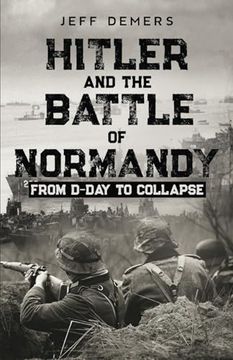Compartir
Hitler and the Battle of Normandy: From D-Day to Collapse (en Inglés)
Jeff DeMers
(Autor)
·
Washington Square Publishing
· Tapa Blanda
Hitler and the Battle of Normandy: From D-Day to Collapse (en Inglés) - DeMers, Jeff
$ 10.36
$ 12.95
Ahorras: $ 2.59
Elige la lista en la que quieres agregar tu producto o crea una nueva lista
✓ Producto agregado correctamente a la lista de deseos.
Ir a Mis ListasSe enviará desde nuestra bodega entre el
Lunes 24 de Junio y el
Martes 25 de Junio.
Lo recibirás en cualquier lugar de Estados Unidos entre 1 y 3 días hábiles luego del envío.
Reseña del libro "Hitler and the Battle of Normandy: From D-Day to Collapse (en Inglés)"
In the tumultuous summer of 1944, the fate of Europe hung in the balance. In Berlin, a clandestine group of German officers conspired to assassinate Hitler before the Allied forces returned to Northern Europe. After June 6, when the Anglo-American troops landed on the beaches of Normandy, the conspirators found a new impetus: overthrow Hitler before the front broke open. This work details the evolution of German strategy during 1944 while weaving in the different strains of the anti-Hitler conspiracies that culminated in the July 20, 1944 attempt on Hitler's life. This history is the only one to present these themes in detail, side-by-side. Part One: From the Rise of Hitler to the Eve of D-Day The opening chapter sets the stage and details the centrality of Hitler to the history of the Second World War in Europe. A lengthy Chapter 2 reviews the strategic background, emphasizing how the Germans had planned and fought their way up until the momentous events of June 6. Chapter 3 details Hitler's endgame. How did he foresee ending this global war he triggered, and what were his goals? We'll also dive into Hitler's belief in his lucky star, his public optimism, and how these informed his strategy. Chapter 4 details the German conceptions of where the Allies would land in France and their plans for defeating the lasing. Chapter 5 explores the various players and factions in 1944 working towards an immediate end to the war and a Germany post-Hitler. Chapter 6 reveals many other German weaknesses and their importance on the eve of the great battle. Finally, Chapter 7 investigates the disposition of German reinforcements. Where had the Germans decided to station the most formidable block of troops and equipment that remained in 1944? Part Two: The Battle of Normandy Chapter 8 introduces us more entirely to General Hans Speidel. Speidel was the bridge between Rommel's headquarters in France and the July 20 plotters seeking to overthrow Hitler. Chapter 9 looks at the day of the invasion and the actions of Speidel - the man most responsible for the German side of the fighting on June 6. We will also look carefully at the command and control of two central reserve units: the 21st Panzer Division - the most powerful, closest formation to the battlefield and the 915th regiment of the 352nd Division, the unit responsible for the area defense of Normandy from Omaha Beach westwards. The 915th regiment was the LXXXIV Corps' reserve on D-Day. Chapter 10 will detail the Fifteenth Army, its use in the campaign, and the prospects of a second Allied invasion in Northern France. The Fifteenth Army defended Upper Normandy and the Pas-de-Calais (where the invasion did not land). The oft-cited example highlights how confused the Germans were by Allied efforts to deceive them about the locations of the actual landings. Finally, Chapter 11 looks at the evolution of the campaign and the changing focus of German strategy after the D-Day landings, emphasizing Hitler's actions before July 20. Part Three: The Plot to Kill Hitler Chapters 12 and 13 take us back to the actions of the July 20 plotters and the bomb Colonel Claus von Stauffenberg detonated under Hitler's conference room table in East Prussia. The Army planned to take over the various military districts in the Reich - a plan for which they did not have the support of most Army units. Chapter 14 looks at the military events after July 20. Chapters 15 and 16 deal with Hitler and the aftermath of July 20 before concluding with his generals and their post-war actions.
- 0% (0)
- 0% (0)
- 0% (0)
- 0% (0)
- 0% (0)
Todos los libros de nuestro catálogo son Originales.
El libro está escrito en Inglés.
La encuadernación de esta edición es Tapa Blanda.
✓ Producto agregado correctamente al carro, Ir a Pagar.

